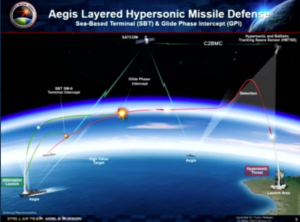
Missile Defense Agency Director Vice Adm. Jon Hill
WASHINGTON: The Missile Defense Agency plans to choose industry winners to launch development of a new Glide Phase Interceptor (GPI) “later this year,” says MDA Director Vice Adm. Jon Hill, but he declined to give a specific date.
“We are assessing the industry inputs,” he told the annual Space and Missile Defense Symposium in Huntsville, Ala. today.
Under MDA’s May 19 Broad Agency Announcement for GPI, interested vendors had until May 25 to turn in white papers outlining their concepts and capabilities. That announcement lists “Summer 2021” as the date for awarding multiple contracts.
“We’re going to take a competitive approach,” Hill stressed.
However, in an interview with Defense News after his symposium presentation, he refused to be drawn on how many companies might be chosen. Instead, he said, how many contracts could be awarded would depend on how much funding is available in the fiscal 2022 budget and beyond.
“We haven’t even gotten to the system requirements review yet,” he said. “We’re gonna down-select … later in the year. Then I have to worry about future budgets, and so that’s what’s really going to throttle” the number of contracts.
According to MDA’s 2022 budget justification documents, the agency has slated $136 million (up from $127 million in 2021) in research, development, test and evaluation (RTD&E) for GPI.
The GPI is designed to knock down high-speed, surface-skimming hypersonic missiles that can maneuver to stay under current missile tracking radar early in their flight. GPI will be fired, at least initially, from a ship-based Aegis Weapon System.
Hypersonic missiles, which spend much of their flight at around 70 kilometers in altitude, also thread their way between the midcourse ballistic missile (in space) interception capabilities of the Standard Missile-3 (SM-3) and the terminal-phase (in the atmosphere) capabilities of the SM-6, Hill told the SMD conference.
 The new interceptors, he said, will be guided primarily by the forthcoming Hypersonic and Ballistic Space Sensor (HBTSS) satellites. Those satellites will be placed in Low Earth Orbit (between about 100 kilometers and 2,000 kilometers), in an inclination that “leverages the testing that we do in the INDO-PACOM region,” he added.
The new interceptors, he said, will be guided primarily by the forthcoming Hypersonic and Ballistic Space Sensor (HBTSS) satellites. Those satellites will be placed in Low Earth Orbit (between about 100 kilometers and 2,000 kilometers), in an inclination that “leverages the testing that we do in the INDO-PACOM region,” he added.
MDA awarded L3Harris $121 million and Northrop Grumman $155 million for each to develop a prototype medium field-of-view sensor for the HBTSS program. The agency asked for $256 million in RTD&E funds for HBTSS in its fiscal 2022 request.
Meanwhile, Hill confirmed in the post-conference interview that the Next Generation Interceptor (NGI) is moving faster than originally planned — meaning that it is likely to be fielded earlier than the current 2028 target date.
“We have a government reference schedule that says 2028, and that’s what contractors bid to, but then they also proposed accelerating,” he said. “So, as we get a closer look in, you know, as they progress along, then I can give you more of a confidence check as to what that would mean. I don’t want to quote a number, but I will tell you, in both cases, it is earlier than the government reference schedule. And what that means is first emplacements earlier, that means flight testing comes earlier.”
Last July, Northern Command head Gen. Glen VanHerk told the Senate Armed Services Committee during his nomination hearing that he was “optimistic” that NGI would “move farther left” to address gaps in capability as the current Ground Based Interceptors (GBIs) age out.
NGI sprang to life in 2019 after cancellation of the sputtering $5.8 billion effort to replace the existing Exo-Atmospheric Kill Vehicle, the kinetic energy kill vehicle carried by GBI and designed to defend the US mainland against long-range ballistic missile attacks.
In March, the Pentagon awarded contracts to teams led by Northrop Grumman and Lockheed Martin to develop the NGI to replace the GBIs now based in California and Alaska. The awards, worth about $1.6 billion each through 2022, will fund technology development. The value of the contracts potentially could more than double once the program is fielded: Lockheed Martin received a contract worth up to $3.693 billion with a performance period through August 2025; Northrop Grumman, $3.932 billion through May 2026.
Northrop Grumman’s inclusion of Raytheon on its team meant that Deputy Defense Secretary Kathleen Hicks made by contracting decision, because Defense Secretary Lloyd Austin, who prior to his confirmation served on Raytheon’s board, recused himself.






















